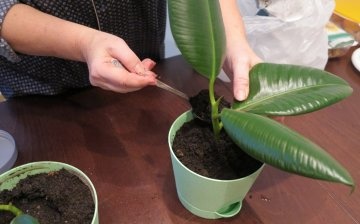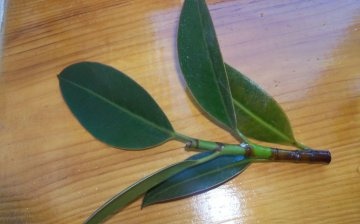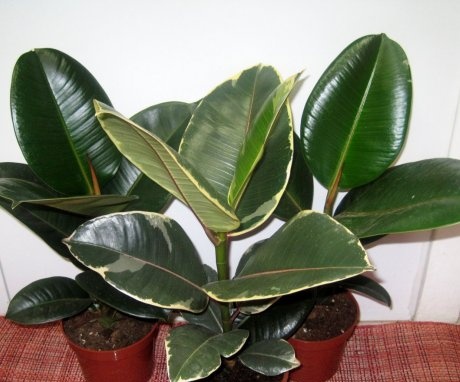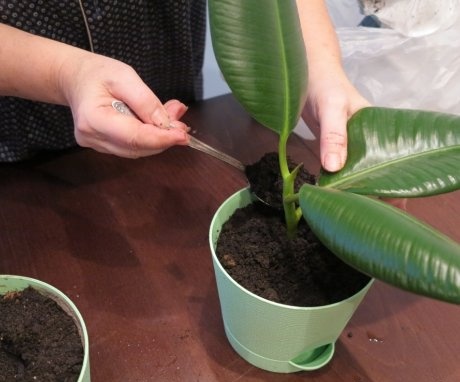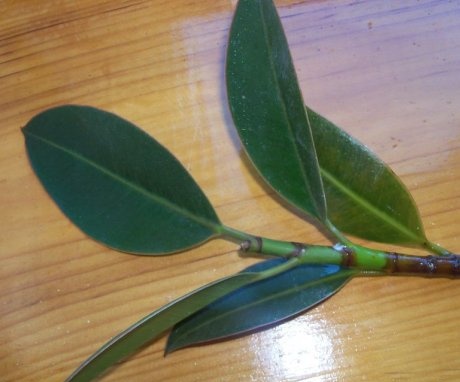Ficus: species, care, transplantation and reproduction
Ficus belongs to the mulberry family. The homeland of ficus is tropical forests. There are more than 800 species of this plant.
Content:
Ficus characteristic
Basically, all types of ficus belong to evergreen trees and shrubs, but deciduous representatives are also found.
The size of the plant depends on the type and place of growth; in nature and in the open field, ficuses grow much higher and larger than in home, indoor conditions.
The leaves on the branches are arranged alternately, opposite in some species. They are oval oblong in shape, they are wide and narrow, lobed. Encountered with notches.
Their color also depends on the variety, they mainly emit green, dark green and white-green tones of the leaves. Flowers are mainly collected in inflorescences in several, sometimes found in the form of a brush or spike.
Ficus species
Popular types of ficus:
- Ficus rubber. A large shrub with strong branching stems. The leaves are large, dense, waxy and glossy from the top and slightly dull from the bottom. They are oval in shape, wide and elongated with a pointed end. Maximum length 45 cm. The color of adult leaves is dark green, while young leaves open reddish-bronze. Small fruits appear in nature, at home this phenomenon is extremely rare.
- Ficus Bengal. This ficus grows in a small tree. Its branches are long, powerful, spreading. In nature, aerial roots are formed on them. Leaves are oval, medium length, up to 25 cm, dense, with pronounced veins. In the room, it is necessary to choose a spacious place and high ceilings for it, since it grows up to 3 meters.
- Ficus is lyre-shaped. This species grows both as a tree and as a shrub, depending on how it is formed. The branches are thick, short and highly branched. The leaves are large, wide, oval, with clearly defined veins.
- Ficus Benjamin. A tree or bush with heavily spreading branches. Benjamin's ficus can reach a height of 2–2.5 meters. Its leaves are small, oval, with a sharp end, hard, densely located on the branches. They are painted motley in green and light beige tones. This variety is an excellent planting agent for office spaces and decorative winter gardens.
Ficus care
Despite the fact that the ficus is tropical plants, caring for him will not bring many problems. Observing a few simple rules, you can enjoy a wonderful plant for more than one decade.
When choosing a place to live in an apartment for a ficus, it should be borne in mind that this plant does not like changes, unnecessary pot movements and turns. A well-lit place with shade from direct sunlight is suitable, especially in summer. During the same period, it is recommended to take the ficus out into the open air, this especially applies to varieties with variegated leaf color.
The temperature regime is maintained in the following range: for the warm period from May to October, the thermometer should be between 25-30 degrees, in the winter cold period - 16-20 degrees.
For most home-grown ficuses, temperatures below 15 degrees for a long period can lead to the death of the plant.
Watering ficus:
- Ficus must be watered when the upper part of the earthen coma dries up, so there is no special regime.
- It all depends on the ambient temperature, air humidity.
- In the summer, overflow is permissible; in the winter months, you should be especially careful with watering.
- Waterlogging of the roots during the dormant period of the plant can lead to its death.
- The water in the watering can should be soft and warm.
- Water the ficus from above several times, and after 20-30 minutes excess water is poured from the pan, which passed through the drainage in the pot.
- The plant can also be moistened by spraying with a spray bottle on hot and dry summer days and during winter heating.
Ficus transplant
Ficus transplant is carried out in the spring. If, after watering, the earthen clod dries up very quickly, and the roots are already visible on the surface, then the time has come to transfer the plant to a wider pot. For young plants, this operation is carried out annually up to 4-5 years.
Plant transplant tricks:
- Before transplanting, the plant is well watered and allowed to stand for 1–2 hours.
- Then the earthen lump with roots is carefully removed.
- The top of the soil is removed, and the roots are lightly chipped off the old substrate.
- It cannot be completely removed, this can severely damage the roots.
- Into a new pot to the bottom lay out a thick layer of drainage and sprinkle 1 cm with a substrate.
- Ficus is installed on top of it, and new fertile soil is poured around and on top to the root collar.
- The fresh layer must be well trampled down and after watering, when the new soil settles a little, and the roots straighten out in a new pot, fill the empty space.
An adult plant can be transplanted once every 2-3 years, while the pot increases by 2-3 cm in diameter. After transplanting, the plant adapts, so its growth and development may slow down.
The plant is fed from spring to early autumn.
Fertilizers specially formulated for ficuses can be purchased at a specialist store. Plants are rare exposed to disease or attacked by pests. The main problems can arise with improper plant care. Burns appear on the leaves from direct sunlight. Also, the edges of the leaves dry out when there is a lack of moisture in the air. When overflowing and stagnant water in the pot, especially in winter, root rot can occur.
Reproduction of ficus
At home, ficuses can be propagated using cuttings, leaves or layering. Cuttings are the most common propagation for this plant. The cut of the twigs is carried out in the spring, so that a strong root system is formed by the fall.
Cuttings must be formed from the tops of shoots 15 cm long. Cut it at an angle at a distance of 1-1.5 cm from the node with the leaf. Immediately after separating the cutting from the mother bush, it must be lowered into the water. The reason for this is that when the plant is damaged, milky sap is released, which quickly hardens and tightens the wound. This can significantly slow down the appearance of roots.
Rooting can be done in soil and water.
When rooting in soil stalk needed soak in water for 2 hours. After, it can be planted in the substrate, after drying it a little. The soil can be purchased prepared or you can mix peat and sand at home, after disinfecting them. The planting depth is adjusted according to the node following the cut. For cuttings, you can organize a greenhouse or put them in an aquarium. New leaves on the shoots are evidence of the emergence of roots. After a while, such a stalk can be transferred to a separate pot.
To root ficus cuttings in water:
- It is best to choose an opaque container.
- At the same time, the air humidity around the cutting should not drop below 85%, and the temperature should be maintained within 25-27 degrees.
- These cuttings can also be placed in an aquarium for good thermoregulation.
- The appearance of roots occurs as early as 2-3 weeks.
- Cuttings can be planted after 5 weeks, when the root system is well strengthened.
When multiplying ficus using a sheet not separately cut a leaf, but a small piece of a branch with a knot. The cut is made along the internode and buried into the substrate along the leaf petiole. The temperature and humidity are maintained the same as when rooting cuttings.
When propagating by layering on a healthy strong branch, cut off the bark in a ring 1-2 cm wide, cover the bare part with wet moss and maintain its moisture. After a while, the roots appear, and when the root system is strengthened, the branch is separated from the mother plant and transplanted into a separate pot.
More information about transplanting ficus can be found in the video.







